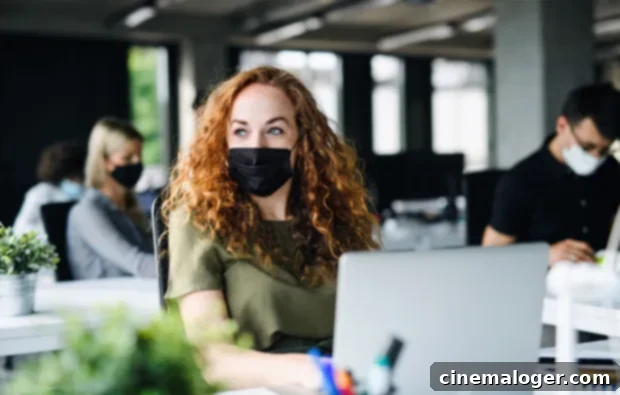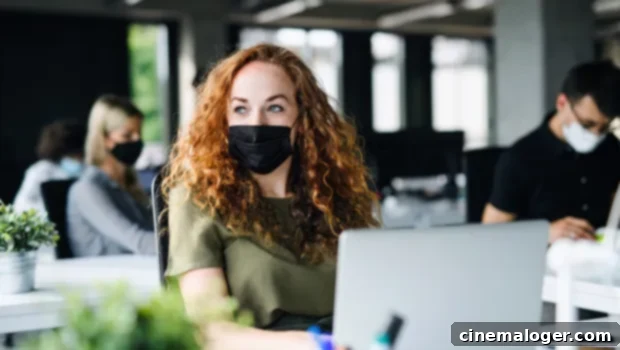The Profound Impact of COVID-19: Unveiling HollywoodLife Readers’ Pandemic Experiences
In August, HollywoodLife initiated a comprehensive survey to understand how the unprecedented coronavirus pandemic was reshaping the lives of our dedicated readers. Two months later, as the global health crisis continued its relentless march across the United States and worldwide, we revisited these insights. After nearly a year marked by social distancing protocols, mandatory face mask usage, stringent hygiene practices, and a widespread shift to remote work and online learning, the landscape of daily life remained largely unchanged for many – with no immediate signs of a return to pre-pandemic normality.
As of October 21st, the global tally of confirmed COVID-19 cases had tragically surpassed 40.9 million, resulting in more than 1.13 million fatalities. The United States continued to bear the heaviest burden, reporting over 8.32 million positive cases and 221,000 deaths. The detailed findings from our reader survey offer a compelling and often poignant glimpse into the myriad ways this crisis has transformed individual lives. Our survey population predominantly comprised women (90%), with a significant majority (64%) falling within the 18 to 54 age bracket. Their responses shed light on the profound and multifaceted shifts experienced throughout 2020:

Workplace Transformations Amidst the Pandemic
The COVID-19 pandemic undeniably triggered significant upheaval in professional environments. While it’s fortunate that only 10% of respondents reported job loss or furlough directly attributable to the health crisis, the overall impact on work lives was substantial. A notable 26% of individuals experienced a direct hit to their income, manifesting as reduced work hours, pay cuts, or temporary furloughs. The survey also revealed a dramatic shift in work locations: 51% of respondents transitioned to full-time or part-time remote work, while 31% continued to work on-site, albeit with the necessary protective gear. Disturbingly, an alarming 12% of respondents indicated they were still working on-site without adequate protection, raising serious concerns about their safety and workplace compliance.
The rapid pivot to remote work, while a necessity for many, has introduced its own unique set of challenges and complexities. A significant 36% of respondents expressed feeling a constant pressure to be “on” or available, blurring the lines between personal and professional life. Compounding this, 40% articulated a distinct loss of separation between their work and home environments. This blending of spheres has created a double-edged sword: while 31% reported working more hours, an equal percentage (31%) felt that they were more productive and achieved more work from home than they typically would in an office setting. Despite these obstacles and the demanding nature of the situation, a majority of remote workers – 51% – expressed gratitude for the opportunity to work from home during the pandemic, highlighting the perceived safety and flexibility it offered.
Navigating Fears: Returning to Work, School, and Social Life
Despite some public narratives suggesting an end to the pandemic’s severity, HollywoodLife readers unequivocally conveyed ongoing apprehension. A significant 70% of respondents harbored fears about returning to their physical workplaces. This sentiment is amplified by the fact that while 40% of companies were still deliberating on return-to-office strategies, only a mere 20% had committed to long-term remote work options for their employees. This creates a challenging dilemma, particularly when considering that 83% of respondents expressed fear about using mass transportation, a critical lifeline for many commuters. The trepidation extended to educational settings as well: among student respondents, a substantial 75% were fearful of resuming in-person classes, a concern undoubtedly fueled by reports of COVID-19 outbreaks on college campuses nationwide.
The fear of contracting COVID-19 profoundly permeated personal and social spheres. Previously avid participants in nightlife and social events, HollywoodLife readers demonstrated an overwhelming avoidance of public gatherings. Specifically, 82% were actively steering clear of live events, 78% avoided movie theaters, and 72% shied away from dining at restaurants and frequenting bars. This widespread caution underscores a deeply ingrained concern for personal health and safety. Furthermore, nearly half of all respondents voiced a significant fear that the virus would inflict negative, long-term consequences on their lives, extending beyond health to economic stability. Indeed, at the time of the survey, the United States economy was experiencing its worst downturn since the Great Depression of the 1930s, signaling that without robust coronavirus relief measures and effective treatments, economic recovery would remain a distant prospect.
A Renewed Craving for Celebrity and Entertainment News
Amidst the turmoil and uncertainty that characterized 2020, one aspect of life persisted and even flourished for HollywoodLife readers: a continued, and in some cases, heightened interest in entertainment and celebrity news. Confined to their homes by lockdown measures, over two-thirds of survey respondents admitted to watching significantly more television. This surge in screen time reflects a broader human need for distraction, comfort, and escapism during stressful periods. Intriguingly, nearly half of the respondents continued to actively seek out celebrity news, albeit in a format that adapted to the new reality. The absence of traditional red carpet events and glamorous public appearances was felt, with 23% specifically missing the vibrant fashion and spectacle these events provided.
However, the pandemic also fostered a different kind of celebrity engagement. Readers found inspiration and reassurance in seeing public figures adhering to safety guidelines – specifically, wearing face masks and practicing social distancing. This provided a sense of normalcy and collective effort. While this often translated to more mundane photos of celebrities engaging in relatable activities like taking walks in their neighborhoods (a pursuit 45% of respondents also engaged in), it nonetheless offered a comforting form of escapism and a reminder that even the most famous individuals were navigating the same global challenges. This shift underscored the evolving role of celebrity culture, from aspirational glamour to a source of shared experience and solidarity.
Desperately Awaiting a Return to Normalcy
After months of isolation, separation from loved ones, and witnessing friends, family, and neighbors grapple with the brutal illness, survey respondents remained deeply anxious about the virus’s long-term implications. A significant 66% expressed a profound fear that life would not revert to pre-COVID conditions within a six-month timeframe. Compounding this anxiety, 60% harbored concerns that a vaccine or effective cure would not be available within the same period, indicating a widespread sense of uncertainty about the future.
The survey also captured the overwhelming longing for what had been lost. When asked what they missed most, the responses were heartfelt and revealing. A remarkable 67% yearned desperately to reunite with friends and family without any restrictions, highlighting the deep emotional toll of social separation. Additionally, 45% eagerly anticipated the simple pleasures of dining in restaurants and enjoying drinks at bars, symbolizing a desire to reclaim casual social interactions and experiences. Yet, above all else, an overwhelming 71% of respondents simply looked forward to life returning to “normal” – or at least, whatever new definition of “normal” might emerge in the post-pandemic era. This collective sentiment underscores a profound yearning for stability, predictability, and the freedom to reconnect and engage with the world in ways that had been so drastically curtailed by the unprecedented global health crisis.
